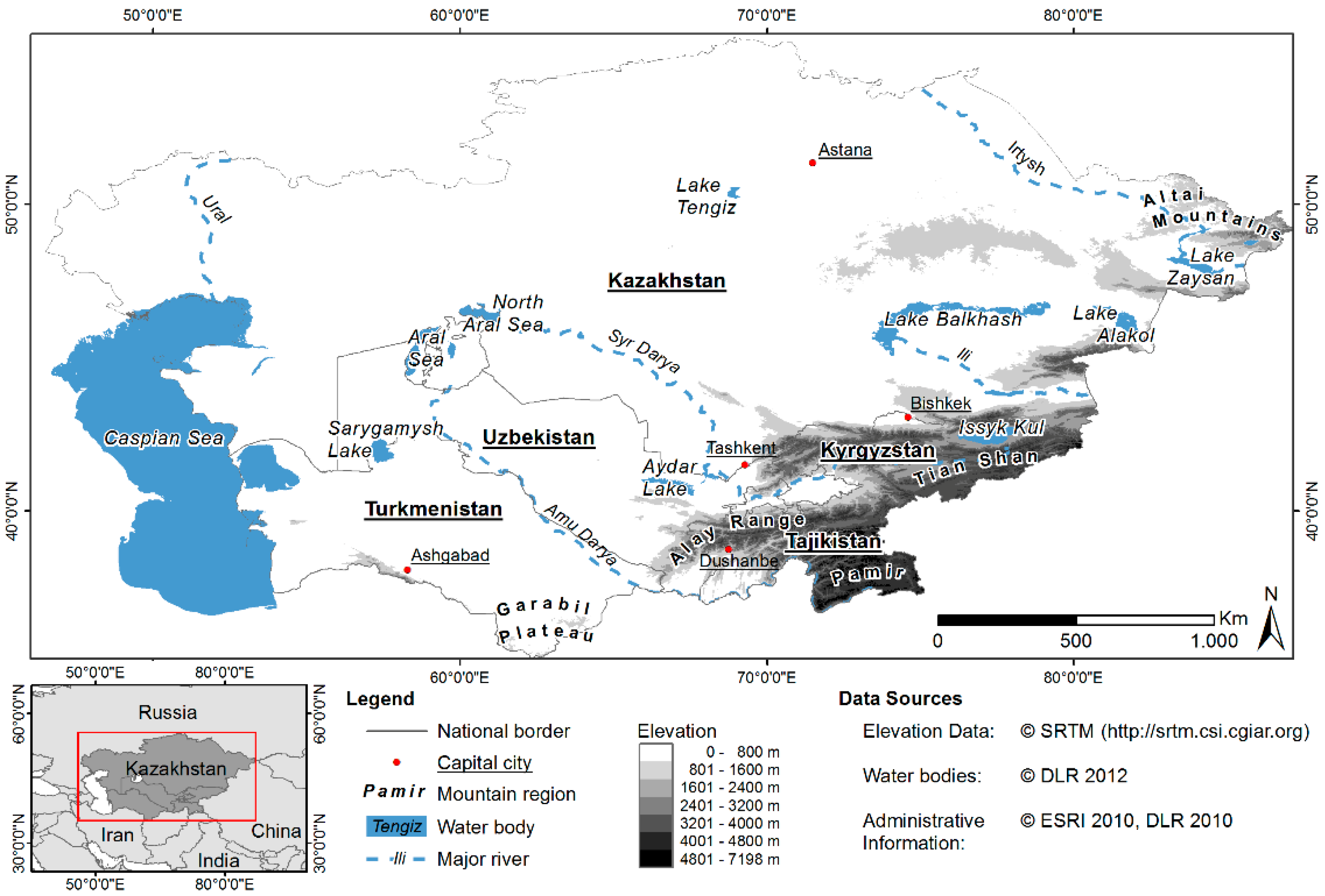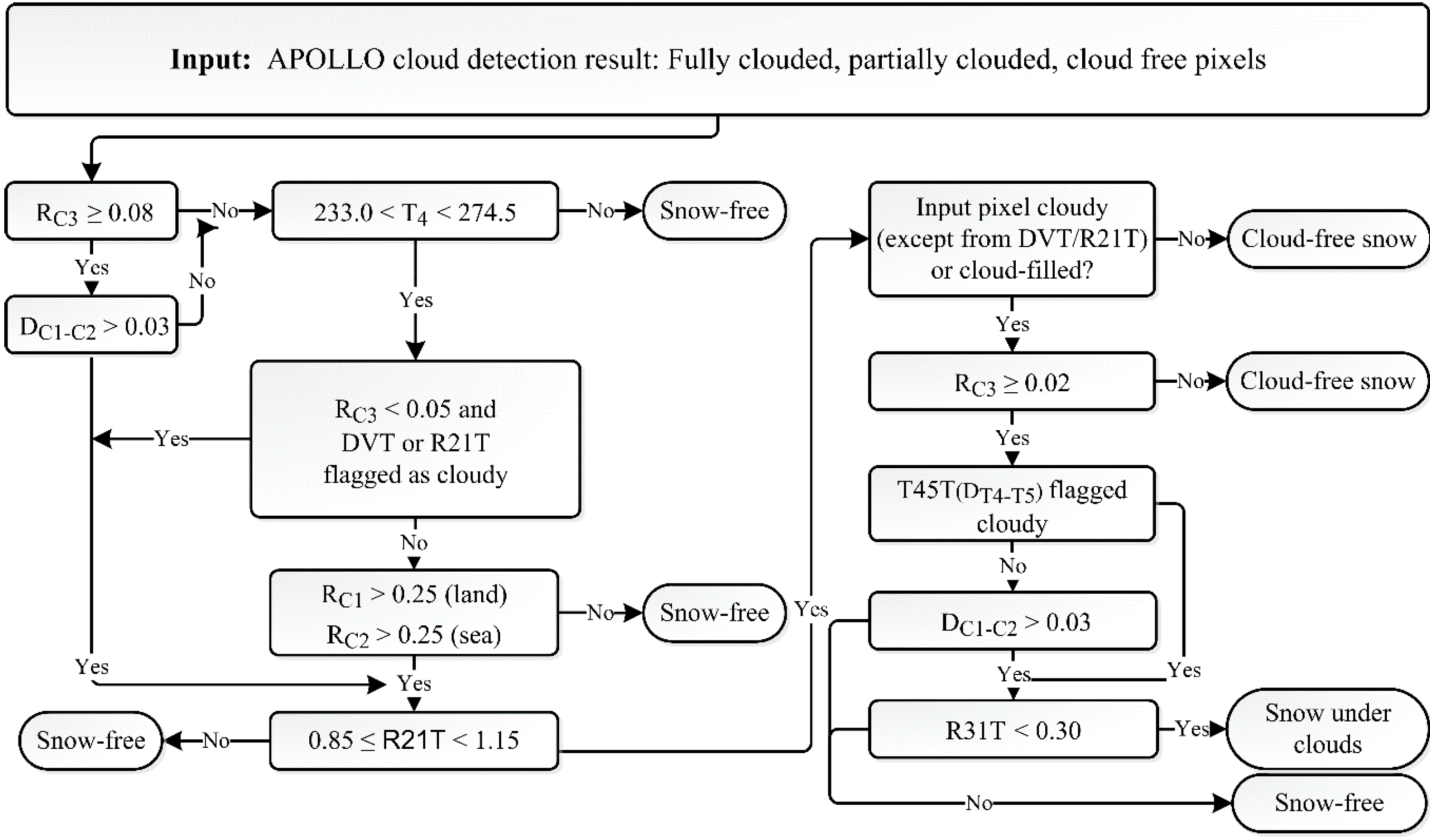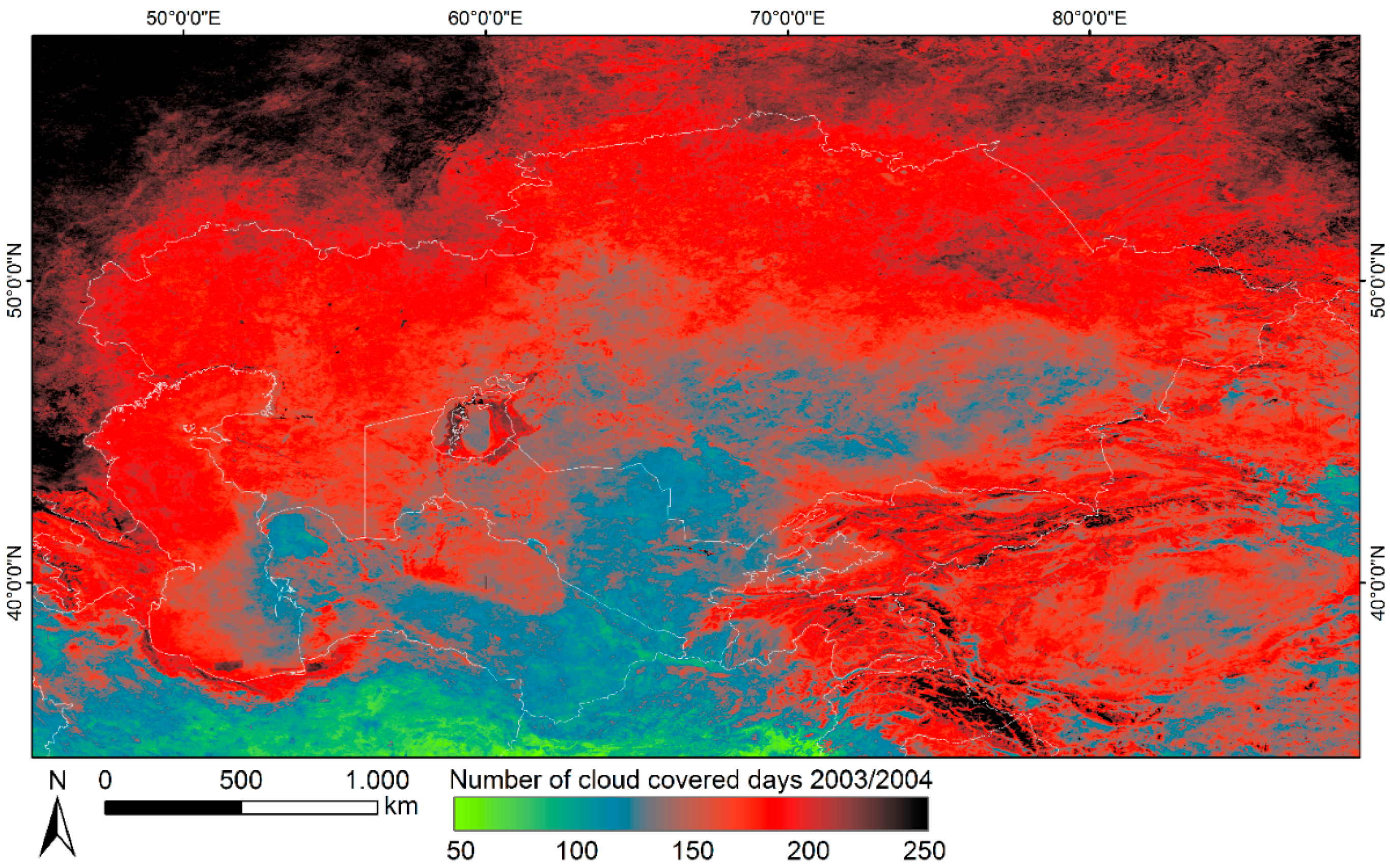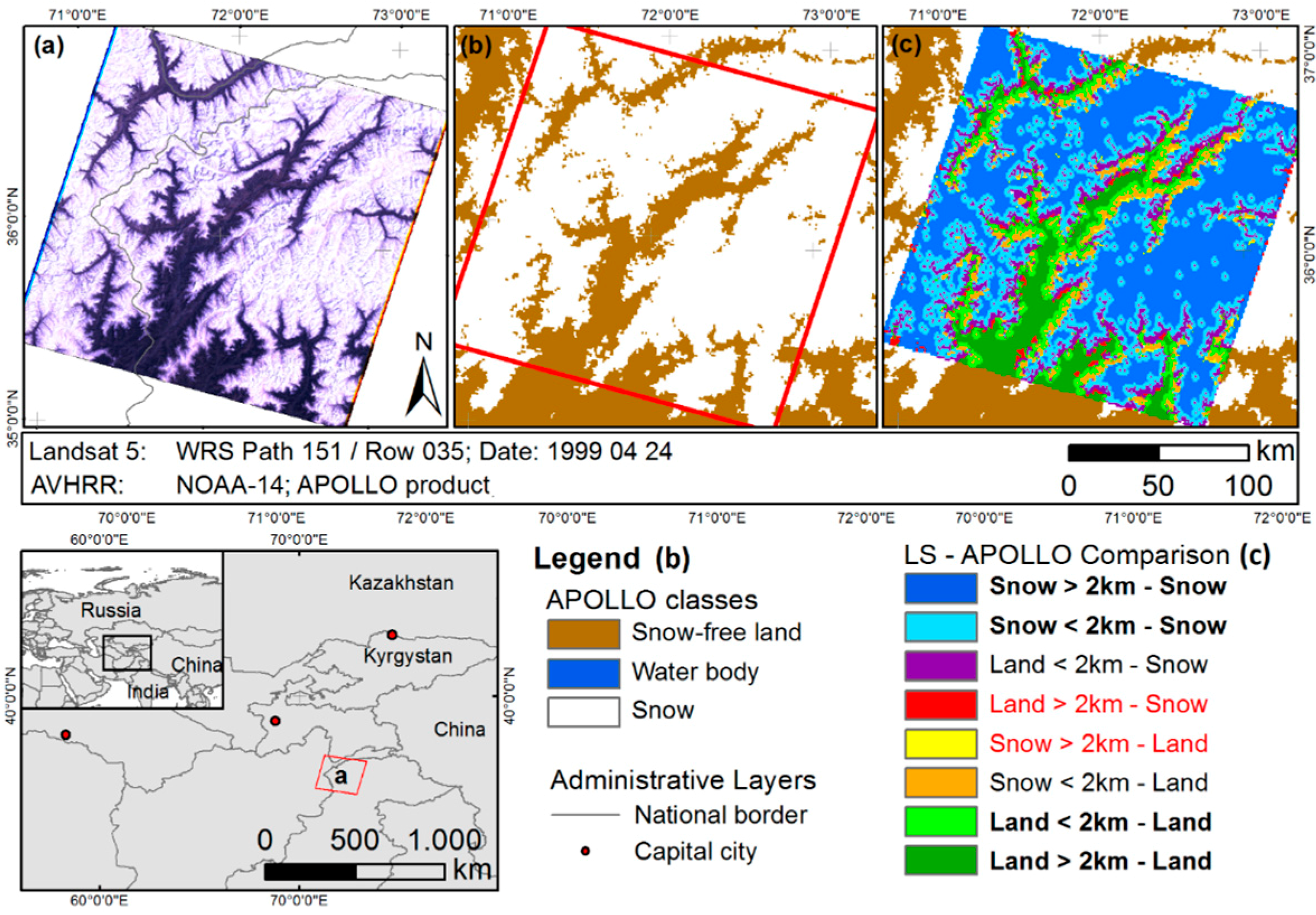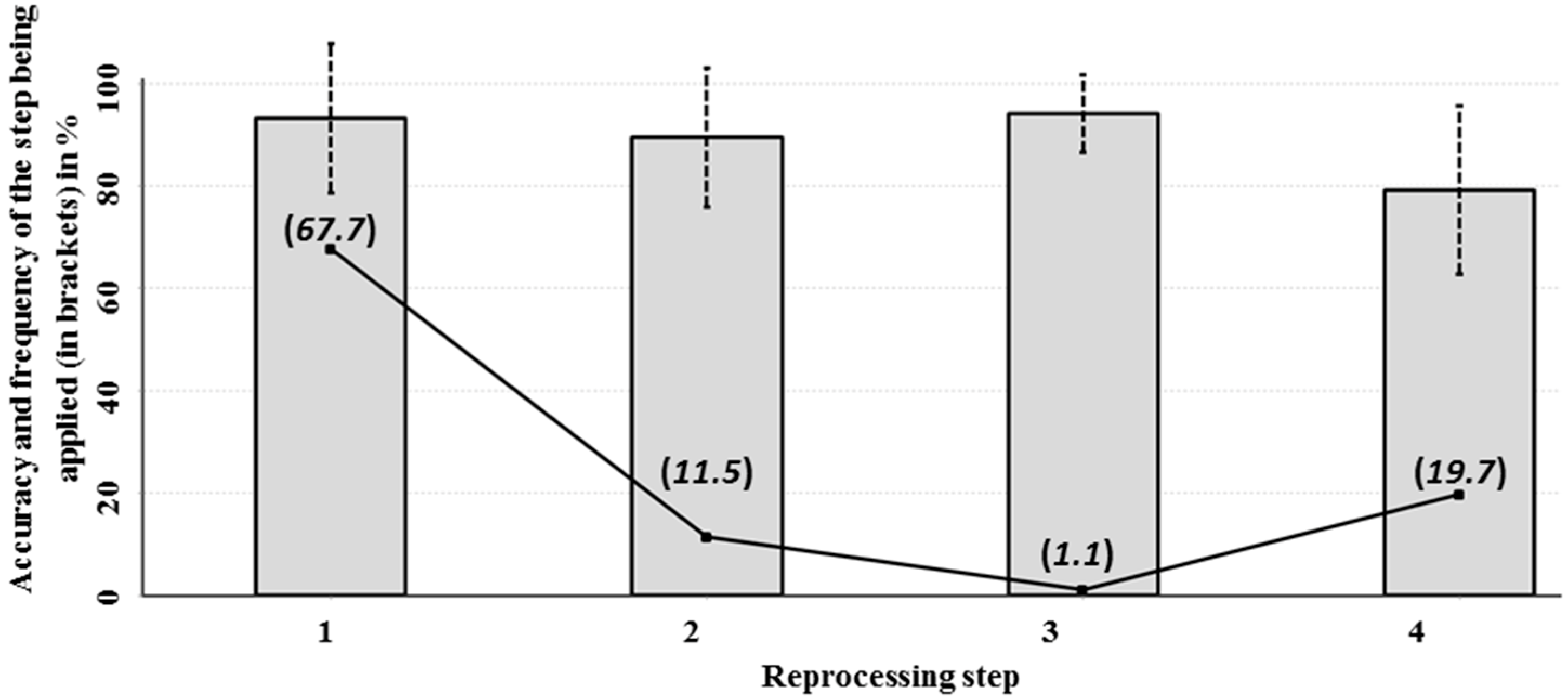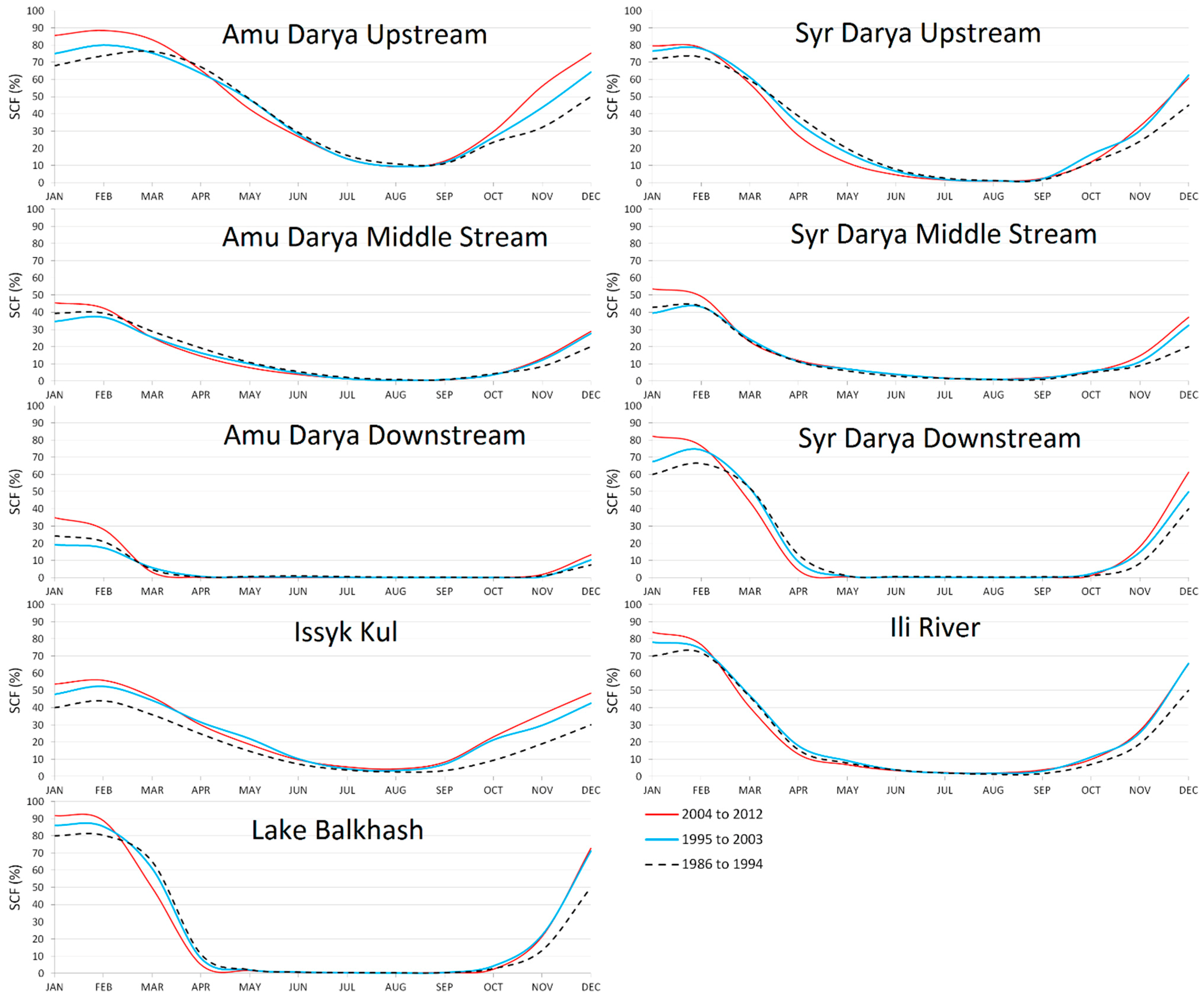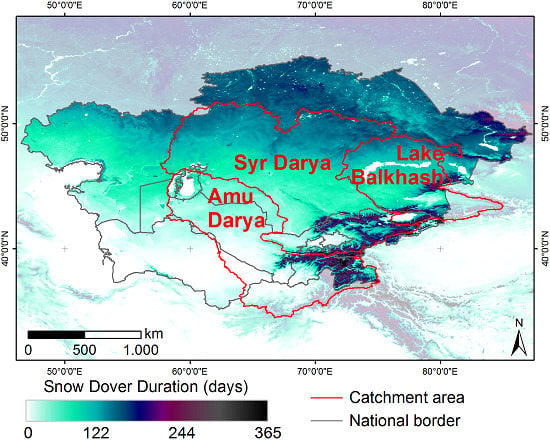1. Introduction
Freshwater availability in Central Asia depends on the occurrence and amount of snowfall (e.g., [
1,
2,
3]). Climate change as well as human interaction have altered the water balance of the region, causing serious water shortages, retreat of glaciers, desertification, and the drying-up of the Aral Sea [
4,
5,
6,
7,
8,
9]. Population growth and the intensifying demand on more water for irrigation and the production of hydropower stand in contrast to the decline of the resource [
10,
11], causing also political tensions to arise [
8,
12]. Against this background a detailed analysis of processes like changing snow cover duration, onset, or melt of snow-covered areas becomes more important.
Table 1 includes some basic information about the study region. The economy of Central Asia depends largely on agriculture, namely cotton and grains [
13]. River runoff of Amu Darya and Syr Darya is of particular importance especially in Tajikistan, Turkmenistan, and Uzbekistan as these countries irrigate large portions of their arable land.
The aim of the presented study is to answer the question how snow cover has changed in the upstream catchments of Central Asia. It is the mountainous region of Pamir and Tian Shan (
Figure 1) where the origins of the two most important streams of Central Asia—Syr Darya and Amu Darya—are located. These rivers form the lifelines of the whole region [
12] and therefore, information about ongoing changes on a sub-catchment scale is desirable. The presented results tie to an earlier research about Central Asian snow cover characteristics between 2000 and 2011 [
14] and follow a similar study about snow cover changes between 1986 and 2008 in the Amu Darya river catchment [
15]. The results of the latter study already show a decreasing trend in Snow Cover Duration (SCD) especially for the high elevation regions with a shift towards earlier snow cover start and melt. Therefore, the secondary aim of our study is to investigate whether the findings of [
15] can be confirmed also for the Syr Darya catchment and whether the results for Amu Darya would conform. This is of particular interest as especially the delineation of snow cover from Advanced Very High Resolution Radiometer (AVHRR) data can pose a challenge.
Table 1.
States of Central Asia—basic information.
Table 1.
States of Central Asia—basic information.
| Country | Area (km2) * | Population * | GDP (Per Capita in US $) * | Irrigated area (% of Arable Land) ** |
|---|
| Kazakhstan | 2,724,900 | 16,724,000 | 14,570 | 6% |
| Kyrgyzstan | 198,974 | 5,700,000 | 1343 | 3% |
| Tajikistan | 141,949 | 8,354,000 | 988 | 35% |
| Turkmenistan | 488,962 | 5,796,000 | 6602 | 31% |
| Uzbekistan | 432,544 | 29,893,000 | 2123 | 89% |
Figure 1.
Overview of Central Asia.
Figure 1.
Overview of Central Asia.
Techniques for mapping snow from remotely sensed data have been developed since the 1960s when TIROS-1 (Television and InfraRed Observation Satellite) allowed for snow cover detection [
17]. Methods and sensors have been improved continuously since that time. Especially when it comes to snow cover mapping for larger regions and longer time series, remote sensing constitutes a reliable and unrivaled data source. The reflection of a snow-covered surface in the visible part of the spectrum can reach 95% and drops near zero in the short-wave infrared. These values may differ considerably depending on grain size and age of the snow crystals as well as the liquid water content. Details about the challenges to map snow cover and discriminate between clouds and snow have been discussed extensively in literature. The interested reader should refer to [
18,
19,
20,
21] for more information.
2. Data Sources
We rely on the longest possible time series of medium resolution remote sensing data that is available on a daily basis and analyze AVHRR and Moderate Resolution Imaging Spectroradiometer (MODIS) data between 1986 and 2014. Spatial and temporal resolutions of these sensors are consistent with the demands for satellite-based data products for climate research formulated by the Global Climate Observing System (GCOS) [
22].
Table 2 gives on overview of existing and upcoming sensors to map snow from the reflective part of the spectrum. Though there are additional sensors like ATSR/AATSR or MERIS available, the need for long-term daily observations limits the selection of input data for the presented study to AVHRR and MODIS. The suitability of earth observation data originating from the reflective part of the spectrum for snow mapping has repeatedly been confirmed in various studies [
18,
21,
23,
24,
25] and the remoteness and sheer size of the study region - combined with the requirement to measure the snow cover extent on a daily basis and over multiple years - leaves not too many alternatives to optical satellite data.
It is possible to map snow cover using Synthetic Aperture Radar (SAR) data, but several limitations prevent their consideration for the presented study: Snow cover only becomes visible under wet snow conditions [
21,
26], and the temporal resolution of SAR sensors is typically too low to derive daily snow cover information for an area as big as the study region of Central Asia (11, 24, 35 days for TerraSAR-X, RADARSAT, Envisat/ASAR data, respectively). Additionally, the time series of available SAR data only ranges back until 1995 (RADARSAT). Passive Microwave (PM) data would be another alternative [
27,
28,
29,
30,
31], but the spatial resolution is way too coarse to derive accurate measurements (pixel size of PM is usually around 25km, e.g., GlobSnow Snow Water Equivalent (SWE) product [
32]). Additionally, PM data is not suited to detect snow cover in mountainous regions [
18,
21,
32]—the most important part of the study region Central Asia as the majority of available freshwater is generated here by snowmelt.
Table 2.
Remote Sensing instruments used to map snow cover from the reflective part of the spectrum.
Table 2.
Remote Sensing instruments used to map snow cover from the reflective part of the spectrum.
| Satellite(s)—Instrument(s) | Operational since/until | Revisit Time | Spatial Resolution | Swath Width |
|---|
| Landsat MSS/TM/ETM+/OLI | 1972/Today | 16–18 days | 30–100 m | 185 km |
| Terra, Aqua-MODIS | 2000/Today | Twice per day | 250–1000 m | 2330 km |
| TIROS/NOAA/Metop AVHRR | 1978/Today | At least daily | 1100 m | 2400 km |
| Envisat/AATSR | 2002/2012 | 2–3 days | 1000 m | 500 km |
| Envisat/MERIS | 2002/2012 | 2–3 days | 300 m | 1150 km |
| ERS-2/ATSR-2 | 1995/2011 | 2–3 days | 1000 m | 512 km |
| Sentinel 2 | to be launched in 2015 | 3–5 days | 10–60 m | 290 km |
| Sentinel 3-OLCI/SLSTR | to be launched in 2015 | 1–2 days | 300–500 m | 1270 km |
| Suomi-NPP-VIIRS | 2011/Today | Daily | 375–750 m | 3040 km |
2.1. AVHRR Data
The AVHRR data were acquired from the National Oceanic and Atmospheric Administration’s (NOAA) Comprehensive Large Array-data Stewardship System (CLASS) [
42]. All available Level 1B (quality controlled with included, but not applied information about calibration and geolocation) data were downloaded, comprising AVHRR generations 1, 2, and 3.
Figure 2 illustrates the varying number of scenes per sensor and year (total number of scenes: ~27,000). The amount of available data turned out to be irregular as especially during the late 1980s many scenes were missing. AVHRR sensors observe the Earth in 5 spectral bands (4 for AVHRR generation 1).
Table 3 gives on overview of the sensor characteristics of all AVHRR channels, including also those not used in the presented study. Generation 1 data (NOAA-6, -8, and -10) only contributes a few hundred scenes for the years before 1992. The discrimination between clouds and snow is a challenging task, and for AVHRR generation 1 with only one thermal infrared channel the quality of snow cover classification deteriorates significantly when compared to generations 2 and 3 [
43,
44]. The format of the Level 1B data is Local Area Coverage (LAC), whose record length is limited to ten minutes.
Figure 2.
AVHRR data acquired from NOAA CLASS.
Figure 2.
AVHRR data acquired from NOAA CLASS.
Table 3.
Spectral band widths (µm) and operational phases of AVHRR sensors.
Table 3.
Spectral band widths (µm) and operational phases of AVHRR sensors.
| Channel * | TIROS-N | NOAA-6, -8, -10 | NOAA-7, -9, -11, -12, -14 ** | NOAA-15, -16, -17, -18, -19 |
|---|
| 1 (VIS) | 0.55–0.90 | 0.58–0.68 | 0.58–0.68 | 0.58–0.68 |
| 2 (NIR) | 0.725–1.10 | 0.725–1.10 | 0.725–1.10 | 0.725–1.00 |
| 3A (MIR) | - | - | - | 1.58–1.64 |
| 3B (MIR) | 3.55–3.93 | 3.55–3.93 | 3.55–3.93 | 3.55–3.93 |
| 4 (TIR) | 10.50–11.50 | 10.50–11.50 | 10.30–11.30 | 10.30–11.30 |
| 5 (TIR) | - | - | 11.50–12.50 | 11.50–12.50 |
| Operational | May 1978–January 1980 | June 1979–September 1991 | August 1981–October 2002 | October 1998–present |
2.2. MODIS Daily Snow Cover Products MOD10A1/MYD10A1
The MODIS daily snow cover products MOD10A1 and MYD10A1 were acquired from the National Snow and Ice Data Center (NSIDC, [
47]) for the years 2000 to 2014. Based on the
snowmap algorithm which was developed especially for MODIS [
38], snow cover information is made available for the whole globe on a daily basis and for both platforms: Aqua (MYD10A1), and Terra MODIS (MOD10A1). The
snowmap algorithm is based on the Normalized Difference Snow Index (NDSI) (Equation (1)) developed by [
48] in 1984:
where R
VIS and R
IR stand for the reflection in the visible and (medium-) infrared spectrum, respectively. For Terra MODIS, bands 4 (VIS) and 6 (IR) are used for the calculation of the NDSI. The Aqua MODIS product relies on bands 4 and 7, as band 6 is non-functional [
49]. The NDSI exploits the typical spectral characteristics of snow: High reflection in the visible part of the spectrum, which drops near zero in the infrared region. An NDSI higher 0.4 is a good indicator for snow [
38,
50]. The
snowmap algorithm uses additional tests to increase the accuracy of the snow cover product and to prevent misclassifications over water bodies and forested areas (10% minimum reflectance threshold in band 4, lower NDSI threshold over forested regions). Fractional snow cover information per pixel is also included in the MOD10A1 and MYD10A1 product. The details about the fractional snow cover component can be found in [
51]. They are not reviewed here as only the binary snow information is used for the presented study. The accuracy of the final MODIS daily snow cover product reaches 93% [
52] as it was confirmed by various independent studies throughout the world [
50,
53,
54,
55,
56]. Snow depth [
57], land cover type [
52], and the transition zone between snow covered and snow free area [
58] can compromise the accuracy. Additionally, the accuracy is given only for clear sky pixels. It is know from several studies that the MODIS cloud detection scheme tends to overestimate clouds due to misinterpretation of snow [
59,
60].
For the presented study, a total number of ~76,000 MODIS snow cover datasets (MOD10A1/MYD10A1) were used. The products provide a thematic layer containing classes for snow, snow-free land, sea ice, water, and clouds. This thematic information is not available from the raw AVHRR data and has to be derived before snow cover parameters used to analyze snow cover trends can be produced.
4. Results
SCD, SCD
ES, and SCD
LS are calculated for all hydrological years between 1986/1987 and 2013/2014. Derived for entire Central Asia these datasets constitute a large collection of spatial data, which is too extensive to include in this section. Some results of SCD, SCD
ES, and SCD
LS for the years between 2000 and 2012 have been published in [
14]. Therefore, only one map containing the mean SCD for the period between 2000 and 2013 is depicted in
Figure 8.
This map illustrates how SCD is distributed in whole Central Asia (
Figure 8d) as well as within the single catchment areas (
Figure 8a–c): Longest SCD is found within the mountainous region to the south and southeast. It also demonstrates that when analyzing the hydrology of an area, political boundaries do not necessarily coincide with the natural border of a catchment: Amu Darya is covering six different nations: Kazakhstan, Kyrgyzstan, Tajikistan, Turkmenistan, Uzbekistan, and Afghanistan. Even though Afghanistan is not part of the study about snow cover in Central Asia, the part falling within the Amu Darya River catchment is therefore included in the statistics. The same is true for the Lake Balkhash catchment: The upper reaches of the Ili River, which drains into Lake Balkhash, are situated on Chinese territory and also included in the statistics.
Figure 8.
Amu Darya (a), Syr Darya (b), and Lake Balkhash (c) with subcatchments and mean Snow Cover Duration between 2000 and 2013. Overview of whole Central Asia (d) with all catchment areas highlighted in red.
Figure 8.
Amu Darya (a), Syr Darya (b), and Lake Balkhash (c) with subcatchments and mean Snow Cover Duration between 2000 and 2013. Overview of whole Central Asia (d) with all catchment areas highlighted in red.
The subcatchments of Amu Darya (
Figure 8a) and Syr Darya (
Figure 8b) have been divided into upper-, middle-, and down-stream catchments in order to provide clearer results within this section. These zones are highlighted in different colors in
Figure 8. Lake Balkhash (
Figure 8c) only consists of three catchment zones and has not been differentiated any further.
As the runoff in Central Asia’s rivers is highly snowmelt dominated [
3,
75,
76] we are interested in the changes of snow cover within these river basins. The analysis of the time series of daily snow cover data for these catchments may help identifying possible long term changes of snow cover characteristics. For each group of subcatchments (upper, middle, and downstream) we aggregate the snow cover and calculate the mean Snow Cover Fraction (SCF) within the subcatchment group. The mean SCF indicates the areal percentage of a catchment being covered by snow at a certain time. To highlight the long term changes of snow cover characteristics within the catchment groups, we aggregate the mean SCF not only by month, but also for several years, and compare eight-year long periods against each other. The result of this analysis is illustrated in
Figure 9. For each group of subcatchments, a diagram is included that shows the mean SCF for each month for three different eight-year periods: 1986 to 1994, 1995 to 2003, and 2004 to 2012. 2013 is not depicted in
Figure 9. Years 1994 and 1999 stood out due to insuperable data gaps and have also been excluded from the calculations of the mean SCF results.
The plots in
Figure 9 help to illustrate several snow-cover characteristics: First of all, the SCF magnitude describes the mean snow cover percentage of the whole catchment group per month. Some plots differ between the three time periods, giving a hint whether snow cover characteristics changed over time. Important information included in
Figure 9 is those points where the plots from different periods converge or even cross each other’s path: Here, the speed of snow cover depletion or aggregation differs between the time periods. The steepness of the curves is the third valuable information: it indicates how fast snow cover aggregation and snow cover melt occur (though especially the latter is of interest for hydrological analyses).
Figure 9.
Mean Snow Cover Fraction (SCF) for eight-year periods between 1986 and 2012 for Upstream, Middle Stream, and Downstream catchments of Amu Darya, Syr Darya, and Lake Balkhash catchment areas.
Figure 9.
Mean Snow Cover Fraction (SCF) for eight-year periods between 1986 and 2012 for Upstream, Middle Stream, and Downstream catchments of Amu Darya, Syr Darya, and Lake Balkhash catchment areas.
A statistical trend of SCD, SCD
ES or SCD
LS cannot be identified from
Figure 9 without further analyses, though some of the diagrams already give a superficial idea of the possible result. We conducted Mann-Kendall tests on the time series of snow cover data. The same tests were applied in a similar study for the Amu Darya River basin [
15]. We decided to apply the same analysis in order to make the results from both studies comparable.
Table 5 displays the slope (days per year) of SCD, SCD
ES or SCD
LS as derived from the time series of 28 successive years (again 1994 and 1999 were excluded from the time series and treated as missing values). Significant trends are indicated by bold letters while italic show non-significant slopes. The catchment groups are again the same as in
Figure 8.
The trends from
Table 5 can cover a wide range of different elevation zones. Some of the catchments (especially middle and upstream) cover altitude ranges from thousand meters and more. Because snow cover occurrence is highly dependent on elevation [
67,
77,
78] and climate change affects higher mountain ranges more severely [
79,
80] it is important to analyze snow cover changes within different elevation zones. We used a DEM to extract possible trends in SCD
ES and SCD
LS for every 100 m zone within Central Asia.
Table 6 contains the results of this DEM analysis, again for the full time series of 28 hydrological years between 1986/1987 and 2013/2014. This table also includes the land percentage covered by each of the elevation zones (in the
share field) to give a better impression of how prominently a zone is represented among the whole study area.
Table 5.
Trend of SCDES and SCDLS per catchment group between 1986/1987 and 2013/2014.
Table 5.
Trend of SCDES and SCDLS per catchment group between 1986/1987 and 2013/2014.
| Catchment | SCDES Slope * | SCDLS Slope * | SCD Slope * |
|---|
| Amu Darya Upstream | 0.57 | −0.40 | 0.44 |
| Amu Darya Middle Stream | 0.22 | −0.32 | 0.03 |
| Amu Darya Downstream | 0.25 | 0.17 | 0.49 |
| Syr Darya Upstream | 0.58 | −0.36 | 0.36 |
| Syr Darya Middle Stream | 0.40 | −0.41 | −0.04 |
| Syr Darya Downstream | 0.75 | 0.03 | 0.98 |
| Issyk Kul | 0.72 | −0.27 | 0.73 |
| Ili River | 0.73 | −0.30 | 0.22 |
| Lake Balkhash | 0.99 | −0.06 | 1.09 |
Table 6.
Trend of SCDES and SCDLS per elevation level between 1986/1987 and 2013/2014.
Table 6.
Trend of SCDES and SCDLS per elevation level between 1986/1987 and 2013/2014.
| Elevation | SCDES Slope * | SCDLS Slope * | Share ** | Elevation | SCDES Slope * | SCDLS Slope * | Share ** |
|---|
| 0–100 m | 0.76 | 0.43 | 14.99 | 3501–3600 m | 1.10 | −0.32 | 0.28 |
| 101–200 m | 1.28 | 0.51 | 23.56 | 3601–3700 m | 1.15 | −0.26 | 0.26 |
| 201–300 m | 1.46 | 0.53 | 15.50 | 3701–3800 m | 1.23 | −0.24 | 0.25 |
| 301–400 m | 1.63 | 0.54 | 9.62 | 3801–3900 m | 1.33 | −0.06 | 0.24 |
| 401–500 m | 1.38 | 0.54 | 9.56 | 3901–4000 m | 1.32 | −0.10 | 0.23 |
| 501–600 m | 1.42 | 0.49 | 4.79 | 4001–4100 m | 1.26 | −0.03 | 0.21 |
| 601–700 m | 1.34 | 0.42 | 3.59 | 4101–4200 m | 1.06 | −0.16 | 0.20 |
| 701–800 m | 1.26 | 0.33 | 2.61 | 4201–4300 m | 1.07 | −0.06 | 0.18 |
| 801–900 m | 1.34 | 0.34 | 1.84 | 4301–4400 m | 1.12 | −0.04 | 0.16 |
| 901–1000 m | 1.34 | 0.36 | 1.19 | 4401–4500 m | 1.19 | 0.01 | 0.14 |
| 1001–1100 m | 1.27 | 0.43 | 0.78 | 4501–4600 m | 1.23 | 0.05 | 0.13 |
| 1101–1200 m | 1.21 | 0.53 | 0.57 | 4601–4700 m | 1.28 | 0.09 | 0.11 |
| 1201–1300 m | 1.14 | 0.47 | 0.46 | 4701–4800 m | 1.40 | 0.15 | 0.09 |
| 1301–1400 m | 1.10 | 0.46 | 0.40 | 4801–4900 m | 1.37 | 0.16 | 0.08 |
| 1401–1500 m | 1.08 | 0.42 | 0.37 | 4901–5000 m | 1.38 | 0.28 | 0.07 |
| 1501–1600 m | 1.02 | 0.34 | 0.33 | 5001–5100 m | 1.48 | 0.41 | 0.05 |
| 1601–1700 m | 1.21 | 0.36 | 0.37 | 5101–5200 m | 1.62 | 0.54 | 0.04 |
| 1701–1800 m | 1.16 | 0.30 | 0.34 | 5201–5300 m | 1.58 | 0.57 | 0.03 |
| 1801–1900 m | 1.02 | 0.18 | 0.35 | 5301–5400 m | 1.59 | 0.62 | 0.02 |
| 1901–2000 m | 0.97 | 0.13 | 0.34 | 5401–5500 m | 1.58 | 0.58 | 0.01 |
| 2001–2100 m | 0.90 | 0.01 | 0.32 | 5501–5600 m | 1.52 | 0.67 | 0.01 |
| 2101–2200 m | 0.83 | −0.04 | 0.30 | 5601–5700 m | 1.52 | 0.66 | 0.00 |
| 2201–2300 m | 0.80 | −0.12 | 0.28 | 5701–5800 m | 1.18 | 0.81 | 0.00 |
| 2301–2400 m | 0.80 | −0.15 | 0.27 | 5801–5900 m | 1.16 | 0.76 | 0.00 |
| 2401–2500 m | 0.78 | −0.21 | 0.26 | 5901–6000 m | 1.07 | 0.83 | 0.00 |
| 2501–2600 m | 0.75 | −0.22 | 0.26 | 6001–6100 m | 0.85 | 0.69 | 0.00 |
| 2601–2700 m | 0.75 | −0.27 | 0.25 | 6101–6200 m | 0.56 | 0.55 | 0.00 |
| 2701–2800 m | 0.75 | −0.31 | 0.25 | 6201–6300 m | 0.67 | 0.72 | 0.00 |
| 2801–2900 m | 0.72 | −0.36 | 0.24 | 6301–6400 m | 0.34 | 0.72 | 0.00 |
| 2901–3000 m | 0.76 | −0.40 | 0.25 | 6401–6500 m | 0.55 | 0.82 | 0.00 |
| 3001–3100 m | 0.81 | −0.38 | 0.26 | 6501–6600 m | 0.43 | 0.68 | 0.00 |
| 3101– 3200 m | 0.87 | −0.38 | 0.28 | 6601–6700 m | 0.62 | 0.60 | 0.00 |
| 3201–3300 m | 0.87 | −0.38 | 0.28 | 6701–6800 m | 0.22 | 0.33 | 0.00 |
| 3301–3400 m | 0.96 | −0.35 | 0.28 | 6801–6900 m | 1.56 | 0.20 | 0.00 |
| 3401–3500 m | 0.99 | −0.32 | 0.27 | | | | |
5. Discussions
The study of changing snow cover characteristics produced a large set of results. Twenty-eight years of SCD, SCD
ES and SCD
LS have been processed from more than 20,000 raw AVHRR scenes and around 76,000 MODIS snow cover product datasets. The processed area comprises 4 Mio km
2, which, combined with the long time series of medium resolution remote sensing data, causes a huge amount of data. We tried to select and present only those of utmost interest for the scientific community which turned out to be a difficult task given the broad spectrum of possible applications/analyses that become possible from a time series of snow cover data—as already outlined in
Section 1. The presented results (
Figure 8 and
Figure 9;
Table 5 and
Table 6) describe basically three findings:
The general characteristics of SCD within Central Asia.
Figure 8 depicts the mean SCD between 2000/2001 and 2013/2014 for the main catchments areas (
Figure 8 (a–c)) as well as for the whole area of Central Asia (
Figure 8d). SCD increases by around four days per 100 m elevation. The mountainous regions in the south and southeast contain the highest values of SCD. The glaciers of Central Asia are located in this region too. It is the origin of the most significant rivers of Central Asia: Amu Darya, Syr Darya, and Ili River. In the plains, SCD increases by around 5 days per degree latitude until mean SCD reaches 140 in the most northern parts (at around 54° N).
Figure 8 (a–d) describe the SCD as it can be expected today. However; the variability within the time series is huge (which is not shown here but for example in [
14]). Every year reveals its own peculiarities but the results behind
Figure 8 can be used to analyze and compare every upcoming snow cover season against these mean conditions to identify abnormal conditions.
The diagrams in
Figure 9 and the statistics from
Table 5 describe an important change in snow cover characteristics since 1986: The snow cover season is shifting towards an earlier time. The slope of SCD
ES is positive for all catchment groups, meaning that the snow cover season is generally starting earlier today than in the late 1980s. Except for Amu Darya Middle stream, all of the presented trends are significant. SCD
LS on the other hand is affected by a negative slope for most catchment groups except two, which are located downstream. The significance of these slopes is not as distinct as it is for the early season, but the most essential catchments in the upstream region show a significant level of 0.05. This is an important finding as most of Central Asia’s runoff is generated within these upstream catchments and a shift towards earlier snow cover onset and melt can influence the water availability of the whole region considerably.
The results presented in
Table 6 are segmented according to elevation levels of 100 m and show another very important finding about snow cover changes in Central Asia: The slope of SCD
ES is positive for all elevation zones regardless of their altitude while most of these trends are significant. In other words: Snow cover is starting earlier every year since 1986 throughout all elevation ranges. The slopes of SCD
LS on the other hand are two-sided: Below 1800 m, the trend is significantly positive, describing a prolonged snow cover season with later snow cover melts. Between an altitude of 1800 and 2500 m the situation can best be interpreted as a transition zone: The positive trend is still present at the beginning but it is not significant anymore. With increasing altitude, the trend switches to a negative but not yet significant value. Only above 2500 m, the slope of SCD
LS becomes significantly negative. In this region, snow cover melt occurs earlier today than in the late 1980s and can be expected to continue developing in this direction also in the future. After the altitude reaches 3300 m, the negative trend is still present but not significant anymore as snow cover development is again entering a transition zone of unstable character. Above 5500 m, the trend is significantly positive again.
We have to consider two points when analyzing snow cover according to elevation for whole Central Asia: It is a vast area with 4 Mio km
2 so generalizing over elevation ranges also means generalizing over several degrees latitude and longitude, including different climatic regions as well. This is especially true for the lower altitudes, as most of Central Asia (~87%) is situated below 800 m elevation. Most of the hills and mountains situated above 800 m are located in the south and southeast and therefore, statistics from these regions are more significant. The second point is the aspect of the mountain sides: when averaging over elevation zones, both south and north facing slopes are aggregated to one single class. The difference between the northern side where solar insulation is comparably low, and the southern side with opposed insulation characteristics, can lead to a 2.8 times higher heat input on the southern side [
78]. These differences are not considered within our analyses—partly because the 1 km resolution of the AVHRR data is not suited to derive sophisticated results on such regional scales.
When it comes to the interpretation of the presented results and the discussion of the possible long term consequences, the changes of SCDES and SCDLS play a most significant role: The earlier SCDES can be observed through all elevation ranges and in all major catchment groups. The consequences for Central Asia’s water availability are marginal though, as the water is stored within the snowpack and released only after snowmelt. Therefore, changes in SCDLS are much more important. The negative SCDLS trend within major catchment groups of Amu Darya, Syr Darya, and Ili River is proof that Central Asia’s hydrology faces fundamental changes. The results extracted from optical remote sensing data are not suitable to state about snow depth (and therefore water content of a snowpack), but the fact that snowmelt is occurring up to eleven days earlier today than in 1986 (in case of Amu Darya and Syr Darya Upstream catchments for example) clearly emphasizes the significance of the findings.
The primary aim of the study—to analyze how snow cover has changed in Central Asia—has already been addressed to within the discussions above. The second aim—to compare the obtained results with a similar study about snow cover changes within Amu Darya catchment—is yet to be answered. Some of the conclusions drawn by [
15] differ slightly from what we found during our investigations. A general negative trend of SCD that was identified by the authors of this study could not be confirmed for Central Asia. The trend towards earlier snow cover melts and for some areas earlier snow cover onset, however, coincides with what we analyzed from the snow cover time series. We interpret this as a clear confirmation of the fact that SCD
LS is shifting to earlier dates with each year.
6. Conclusions
We processed time series of medium resolution snow cover data for Central Asia between 1986 and 2014 to calculate the snow cover parameters Snow Cover Duration (SCD), Early Season SCD (SCD
ES) and Late Season SCD (SCD
LS)
, and analyze these parameters for possible trends. Around 20,000 AVHRR Level 1B scenes and 76,000 MODIS snow cover product MOD10A1 and MYD10A1 datasets were used as the basis of the study. The processing included preprocessing and snow cover classification of AVHRR data as well as post-processing of the AVHRR and MODIS snow cover products to estimate snow cover status below clouds. As a result, a positive trend of SCD
ES has been identified from the time series for all of Central Asia’s major hydrological catchments. SCD
LS on the other hand shows a different behavior: The upstream catchments show a significantly negative trend which is caused by fundamental negative snow cover changes in an elevation range between 2100 and 3500 m (significantly negative between 2500 and 3200 m). Though no distinct trend in overall SCD was identified, the shift towards earlier snow cover onset and earlier snow cover melt is proof for a changing cryosphere in Central Asia. Especially the trend of earlier SCD
LS could be confirmed also by comparing our results with an independent study for the Amu Darya River catchment. As the region greatly depends on snow as the most prominent source of freshwater the identified changes point to an ambiguous future: the Aral Sea Disaster, population growth, increasing energy demands, transboundary water issues—these are just few examples for the challenges Central Asia faces right now [
10,
81,
82,
83]. Further analyses are required to assess the possible impact of the identified snow cover changes with regards to all these problems. As the analyzed trends will prolong into the future, techniques should be developed and applied in order to mitigate their effects.
A final remark is necessary referring to the reliability of the presented trend results: Significance has been tested computing the Kendall’s S statistics and deriving Kendall’s tau correlation coefficient to test whether the null hypothesis is true or can be rejected. Those trend results that proved significant according to this test have been marked with bold letters in the respective tables as described in
Section 4. However: Deriving trends over such short time series is a risky endeavor. Unfortunately it was not possible to compute additional robustness tests, which would be desirable to substantiate our findings. Therefore, the presented results should be interpreted with care.
